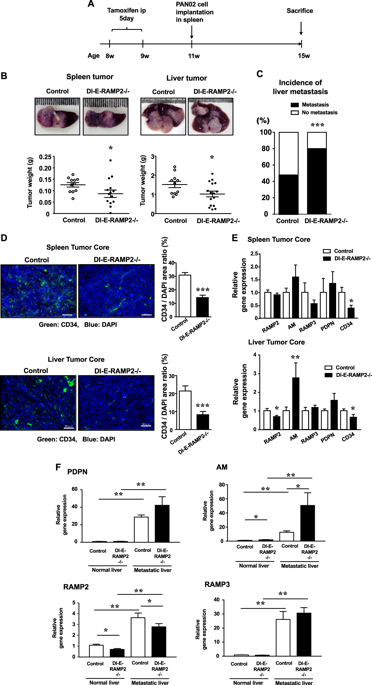Our official English website, www.x-mol.net, welcomes your
feedback! (Note: you will need to create a separate account there.)
Deficiency of the adrenomedullin-RAMP3 system suppresses metastasis through the modification of cancer-associated fibroblasts.
Oncogene ( IF 6.9 ) Pub Date : 2019-11-21 , DOI: 10.1038/s41388-019-1112-z Kun Dai 1, 2 , Megumu Tanaka 1, 2 , Akiko Kamiyoshi 1, 2 , Takayuki Sakurai 1, 2 , Yuka Ichikawa-Shindo 1, 2 , Hisaka Kawate 1, 2 , Nanqi Cui 1, 2 , Yangxuan Wei 1, 2 , Masaaki Tanaka 1, 3 , Shinji Kakihara 1, 3 , Shuhei Matsui 1, 4 , Takayuki Shindo 1, 2
Oncogene ( IF 6.9 ) Pub Date : 2019-11-21 , DOI: 10.1038/s41388-019-1112-z Kun Dai 1, 2 , Megumu Tanaka 1, 2 , Akiko Kamiyoshi 1, 2 , Takayuki Sakurai 1, 2 , Yuka Ichikawa-Shindo 1, 2 , Hisaka Kawate 1, 2 , Nanqi Cui 1, 2 , Yangxuan Wei 1, 2 , Masaaki Tanaka 1, 3 , Shinji Kakihara 1, 3 , Shuhei Matsui 1, 4 , Takayuki Shindo 1, 2
Affiliation

|
Tumor metastasis is a primary source of morbidity and mortality in cancer. Adrenomedullin (AM) is a multifunctional peptide regulated by receptor activity-modifying proteins (RAMPs). We previously reported that the AM-RAMP2 system is involved in tumor angiogenesis, but the function of the AM-RAMP3 system remains largely unknown. Here, we investigated the actions of the AM-RAMP2 and 3 systems in the tumor microenvironment and their impact on metastasis. PAN02 pancreatic cancer cells were injected into the spleens of mice, leading to spontaneous liver metastasis. Tumor metastasis was enhanced in vascular endothelial cell-specific RAMP2 knockout mice (DI-E-RAMP2-/-). By contrast, metastasis was suppressed in RAMP3-/- mice, where the number of podoplanin (PDPN)-positive cancer-associated fibroblasts (CAFs) was reduced in the periphery of tumors at metastatic sites. Because PDPN-positive CAFs are a hallmark of tumor malignancy, we assessed the regulation of PDPN and found that Src/Cas/PDPN signaling is mediated by RAMP3. In fact, RAMP3 deficiency CAFs suppressed migration, proliferation, and metastasis in co-cultures with tumor cells in vitro and in vivo. Moreover, the activation of RAMP2 in RAMP3-/- mice suppressed both tumor growth and metastasis. Based on these results, we suggest that the upregulation of PDPN in DI-E-RAMP2-/- mice increases malignancy, while the downregulation of PDPN in RAMP3-/- mice reduces it. Selective activation of RAMP2 and inhibition of RAMP3 would therefore be expected to suppress tumor metastasis. This study provides the first evidence that understanding and targeting to AM-RAMP systems could contribute to the development of novel therapeutics against metastasis.
中文翻译:

肾上腺髓质素-RAMP3系统的缺乏通过改变癌症相关的成纤维细胞来抑制转移。
肿瘤转移是癌症发病率和死亡率的主要来源。肾上腺髓质素 (AM) 是一种受受体活性修饰蛋白 (RAMP) 调节的多功能肽。我们之前报道过 AM-RAMP2 系统参与肿瘤血管生成,但 AM-RAMP3 系统的功能仍然很大程度上未知。在这里,我们研究了 AM-RAMP2 和 3 系统在肿瘤微环境中的作用及其对转移的影响。PAN02胰腺癌细胞被注射到小鼠的脾脏中,导致自发性肝转移。血管内皮细胞特异性 RAMP2 敲除小鼠 (DI-E-RAMP2-/-) 的肿瘤转移增强。相比之下,RAMP3-/- 小鼠的转移受到抑制,其中,在转移部位的肿瘤周围,podoplanin (PDPN) 阳性的癌症相关成纤维细胞 (CAF) 的数量减少。因为 PDPN 阳性 CAF 是肿瘤恶性肿瘤的标志,我们评估了 PDPN 的调节,发现 Src/Cas/PDPN 信号传导是由 RAMP3 介导的。事实上,RAMP3 缺陷 CAF 在体外和体内与肿瘤细胞共培养时抑制了迁移、增殖和转移。此外,RAMP3-/- 小鼠中 RAMP2 的激活抑制了肿瘤的生长和转移。基于这些结果,我们认为 DI-E-RAMP2-/- 小鼠中 PDPN 的上调增加了恶性肿瘤,而 RAMP3-/- 小鼠中 PDPN 的下调降低了它。因此,预计 RAMP2 的选择性激活和 RAMP3 的抑制会抑制肿瘤转移。
更新日期:2019-11-22
中文翻译:

肾上腺髓质素-RAMP3系统的缺乏通过改变癌症相关的成纤维细胞来抑制转移。
肿瘤转移是癌症发病率和死亡率的主要来源。肾上腺髓质素 (AM) 是一种受受体活性修饰蛋白 (RAMP) 调节的多功能肽。我们之前报道过 AM-RAMP2 系统参与肿瘤血管生成,但 AM-RAMP3 系统的功能仍然很大程度上未知。在这里,我们研究了 AM-RAMP2 和 3 系统在肿瘤微环境中的作用及其对转移的影响。PAN02胰腺癌细胞被注射到小鼠的脾脏中,导致自发性肝转移。血管内皮细胞特异性 RAMP2 敲除小鼠 (DI-E-RAMP2-/-) 的肿瘤转移增强。相比之下,RAMP3-/- 小鼠的转移受到抑制,其中,在转移部位的肿瘤周围,podoplanin (PDPN) 阳性的癌症相关成纤维细胞 (CAF) 的数量减少。因为 PDPN 阳性 CAF 是肿瘤恶性肿瘤的标志,我们评估了 PDPN 的调节,发现 Src/Cas/PDPN 信号传导是由 RAMP3 介导的。事实上,RAMP3 缺陷 CAF 在体外和体内与肿瘤细胞共培养时抑制了迁移、增殖和转移。此外,RAMP3-/- 小鼠中 RAMP2 的激活抑制了肿瘤的生长和转移。基于这些结果,我们认为 DI-E-RAMP2-/- 小鼠中 PDPN 的上调增加了恶性肿瘤,而 RAMP3-/- 小鼠中 PDPN 的下调降低了它。因此,预计 RAMP2 的选择性激活和 RAMP3 的抑制会抑制肿瘤转移。











































 京公网安备 11010802027423号
京公网安备 11010802027423号